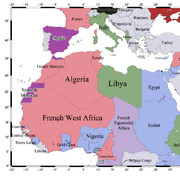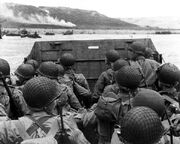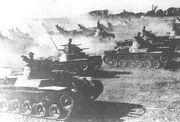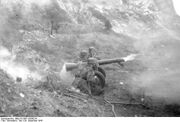The Axis Invasion of Egypt, also known as the Egyptian campaign or Betrieb Fluss (Operation River) was the conquest of Egypt by Axis nations Germany, Spain, and Italy. The invasion began on June 22, 1941, and ended in February 1943. In the end, the capture of Malta allowed fuel ships to reach North Africa, and with extra supplies the Axis conquered Egypt.
The attack came in two directions, with massive German landings at the Delta while a combined Spanish-Italian force to come in from Libya. The Nile Delta campaign was abandoned because of the failure of the western force to defeat the British at El Alamein. With German reinforcements the drive continued and capture Alexandria. The Axis then began a drive toward Cairo, and captured it by February 1942. In the next month the Suez Canal was captured, ending British dominance of the Meditteranean.
The capture of Egypt proved crucial for the Axis war effort. The Axis used Egypt as a springboard into the oil rich Middle East. The oil was then shipped to Japan, which made them decide not to attack America. The Germans occupied most of Egypt, with Italy occupying the Western Desert.
Background

Map of Europe and Africa before World War II
British forces maintained a strong presence in Egypt, and maintained control of the Suez. British forces at the island of Malta had been disrupting Axis shipping lanes for the entire war. All British ships had to come in from the Suez Canal, which was heavily defended along with Egypt. The Axis hoped to attack Egypt to take control of the Suez and eventually starve the defenders of Malta to submission. The control of the Suez would also enable the Axis to send supplies to Japan, which would greatly help them because of American and British embargoes.
Opening Attacks
Several raids by Italian troops disrupted several British garrisons located near the border. On February 22, a raid into British territory destroyed several light tanks and artillery pieces belonging to the 7th Hussars and the Royal Horse artillery. Another raid killed several members of the 11th Hussars and an airfield. A final Italian raid disrupted 60th Rifles Bridage lines around Sidi Barrani in Egypt.

Axis advances in Egypt
The next attack contained the combined Italian and Spanish might. The 10th Army under Mario Berti attack Sidi Barrani, Sollum, and Halfaya Pass. Spanish supply lines allowed the Italians to keep going to Marsa Matruh, where the 60th Rifles set up defensive lines. After several days the city was captured, but during this time the British reorganized and launched their counteroffensive. The Italians, who had dug in at Marsa Matruh, deflected the counterattacks and dealt heavy blows to the British. The arrival of the Spanish 3rd Armored Division forced the British into retreat again, making them regroup at El Alamein.
The Spanish and Italians also launched an attack on Siwa Oasis to knock out the British Long Range Desert Group based there. The Axis attack caught the British off guard, and several waves of attacks eventually forced the British to surrender. This attack prevented the British re-inforcements for upcoming battles. Following the battle the Axis went to join the Battle of El Alamein.
German Landings
In July, following Italian and Spanish successes, the Germans prepared to land in the Nile Delta. Their objective was to establish a beachhead, capture Port Said, than link up with other Axis forces and capture Cairo. Before the invasion the Luftwaffe began to bomb British railroads, airfields, and Port Said.

German soldiers during the invasion
The German landings met little resistance, and quickly went to their targets. Members of the 6th Infantry Division attacked El-Mahalla El-Kubra, which was home for several factories. Several artillery strikes weakened defenses, and the infantry captured the city in two days. The 7th Infantry Division struck Tanta, where a major railroad station was located. After several days of heavy fighting the Germans broke through, and captured the station. This crippled the British defense, as it was harder to move troops now. The 6th Panzer Division attacked Zagazig to gain control over railroads and factories. After two days of fighting the city was brought under control.

German infantry on the beaches
The 3rd Infantry Division and 4th Panzer Division attacked the heavily guarded Port Said. The British lines were made up the XXX Corps, and had made several defensive lines around the city. Neither German division could break through British lines because of British reinforcements. The capture of Tanta and Zagazig prevented the British from sending any reinforcements, and the Germans now had the advantage. Following ten days of fighting the Germans broke through, and forced the British to retreat across the Suez Canal. The two division began to occupy the Canal, preventing the British from entering.
Axis Advance Stalls

British tanks at El-Alamein
The western force continued their march toward Alexandria. Because of recent defeats, Winston Churchill replaced Claude Auchinleck with General Harold Alexander and Lieutenant-General Bernard Montgomery. Alexander placed a defensive lines surrounding El Alamein. During the battle a sandstorm blanketed the Axis forces and caused them to attack in groups instead of a single mass. The British had several defensive fortifacations set up, and had put down mines. The Axis forces had become exhausted, which the British used to their advantage by attacking sections of the Axis. The Axis were forced to retreat.

Free French forces during the battle
The German 164th Light Division and the Italian 101st Motorised Division Trieste came in to reinforce to battered Axis troops. However, heavy artillery barrages destroyed several defenses, which allowed the Australians to attack several important hills to the south. The Spanish 3rd Infantry Division was sent as reinforcements, which allowed the Axis to hold on to their positions at Miteirya Ridge, nicknamed Ruin Ridge by the Australians. Neither side was strong enough to break through, and a stalemate occured.
The stalemate at El Alamein forced the Germans to change their plans, as the Axis were supposed to regroup and hit Cairo by now. This delay would cost the Axis hundreds of casualties.
Operation Karte

The German 6th Army arriving at Tobruk
Following the stalemate at El Alamein Germany was forced to call in the 6th Army from it defensive positions in northern France. It arrived at Tobruk and was sent to the front as reinforcements. The army backed up the Italian Pavia and Brescia divisions, and held off an attack on Ruweisat Ridge by British forces. The next day the 6th Army led an attack Dier el Shien along with the 21st Panzer Division. The attack worked and the British forces were pushed back and suffered heavy casualties. The 6th Army continued to press on and took over several British fortifacations. Another attack destroyed most of the British 7th Armoured Brigade and the 9th Indian Infantry Brigade, which gave the Germans numerical superiority.
The British attempted a final counter attack to take the El Mreir Depression and Ruweisat Ridge. The New Zealanders captured the Depression but the vehicles supporting them were destroyed by the 5th and 8th Panzer Regiment. The New Zealanders retreated and lost control over El Mreir. On Ruweisat Ridge, early attacks by the 69th Infantry Brigade succeeded, but as night fell they lost direction and the attack ended. Another attempt occured but the Germans had fortified the ridge and attacked the British from three sides, forcing them to retreat.
Following the counter attack most of the British forces were decimated. The remaining soldiers headed to Alexandria to take part in the defense of the city.
Battle of Alexandria

German artillery near Alexandria
The Germans in the Delta were forced to retreat due to increasing British pressure. This pressure was finally relieved when the combined Axis force in the west arrived nearly Alexandria. The British hastily set up defenses in the west of the city, but more German reinforcements came, such as the 18th Army and the 2nd Panzer Division. The inexperienced British 1st Armoured Division and the 2nd Armoured Brigade spread out their tanks instead of concentrating them, allowing the western force to split them apart. Several defensive boxes had been established, but continuing Axis shelling and bombing runs destroyed several of them. The western force's success forced the British to send reinforcements and the battered German Nile troops broke through British lines.
The city was then sieged and heavy street fighting took place. The British managed to keep sending supplies to troops inside the city until the German 18th Infantry Division encirced the city in Operation Library. The British troops continued to hold on for two weeks, but the cut off of supplies got to them. Bernard Montgomery, who was commanding troops inside the city, surrended in Mansheyya Square. The battle decimated most of the British forces in Egypt, and only a light defense of Cairo was established. The remaining troops fled to the Sinai Peninsula to await further orders.

